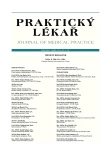Deficit Fluid Volume rating by nurses according to the diagnostic cues of nursing diagnosis
Authors:
R. Zeleníková 1; K. Žiaková 2; L. Sikorová 1
Authors‘ workplace:
Ostravská univerzita v Ostravě, Lékařská fakulta, Ústav ošetřovatelství a porodní asistence, Vedúci: doc. PhDr. Darja Jarošová, PhD.
1; Univerzita Komenského v Bratislave, Jesseniova lekárska fakulta v Martine, Ústav ošetrovateľstva, Vedúci: doc. Mgr. Katarína Žiaková, PhD., mim. prof.
2
Published in:
Prakt. Lék. 2011; 91(12): 731-734
Category:
Of different specialties
Overview
A nurse has an important role in assessing a patient’s hydration. Since dehydration seems to be a serious problem in hospitalized patients, we wanted to know which diagnostic cues are important for nurses to evaluate the fluid volume deficit.
Aim:
The main purpose of the research was to validate the “Deficient Fluid Volume” nursing diagnosis and to find out which defining characteristics are most important and which are less so.
Sample and methods:
Fehring’s Diagnostic Content Validation model was used for validating the nursing “Deficient Fluid Volume” diagnosis. The sample consisted of 135 nurses.
- decreased skin turgor,
- decreased urine output,
- dry mucous membranes,
- decreased tongue turgor,
- decreased venous filling,
- increased urine concentration.
Eleven signs were singled out as minor:
- thirst,
- weakness,
- elevated hematocrit,
- dry skin,
- decreased blood pressure,
- decreased pulse volume,
- decreased pulse pressure,
- increased pulse rate,
- change in mental state, increased body temperature,
- sudden weight loss (except in third spacing).
Conclusion:
The assessment of an imbalance of body fluids requires careful observation by nurses and the monitoring of symptoms, which requires knowledge and understanding of the principles of total body fluid physiology.
Key words:
deficient fluid volume, validation, nursing diagnosis.
Sources
1. Mythen, M., Vercueil, A. Fluid balance. Vox sanguinis, 2004, 87, Suppl. 1, p. 77-81.
2. Vivanti, A., Harvey, K., Ash, S. Developing a quick and practical screen to improve the identification of poor hydration in geriatric and rehabilitative care. Arch. Gerontol. Geriatr. 2010, 50(2), p. 156-164.
3. Ferry, M. Strategies for ensuring good hydration in the elderly. Nutr. Rev. 2005, 63(6), p. 22-29.
4. NANDA International. Nursing Diagnoses: Definitions & Classification 2009–2011. Herdman, T.H. (ed.). 1th ed. Chichester: Wiley-Blackwell, 2009. 435 p. ISBN 978-1-4051-8718-3.
5. Žiaková, K. a kol. Ošetrovateľský slovník. 1. vyd. Martin: Osveta, 2009. 218 s. ISBN 978-80-8063-315-8.
6. Fehring, R.J. Validation diagnostic labels: standardized methodology. In Hurley, M.E. (ed.). Classification of nursing diagnoses: Proceedings of the Sixth conference. St. Louis: Mosby, 1986, p. 183–190.
7. Zeleníková, R., Žiaková, K., Čáp, J. a kol. Návrh kritérií výberu expertov pre validizáciu ošetrovateľských diagnóz v ČR a SR. Kontakt, 2010, 12(4), p. 407-413.
8. Gershan, J.A., Ross, J.A., Smejkal, C. et al. Fluid volume deficit: Validating the indicators. Heart Lung. 1990, 19(2), p. 152-156.
9. Gross, C.R., Lindquist, R.D., Woolley, A.C. et al. Clinical indicators of dehydration severity in elderly patients. J. Emerg. Med. 1992, 10(3), p. 267-274.
10. Vivanti, A., Harvey, K., Ash, S., Battustutta, D. Clinical assessment of dehydration in older people admitted to hospital: What are the strongest indicators? Arch. Gerontol. Geriatr. 2008, 47(3), p. 340-355.
11. Hoff, R.G., Dijk, G.W., Algra, A. et al. Fluid balance and blood volume measurement after aneurysmal subarachnoid haemorrhage. Neurocrit. Care 2008, 8(3), p. 391-397.
12. Elgart, H.N. Assessment of fluids and electrolytes. AAACN Clin. Issues 2004, 15(4), p. 607-621.
13. Sikorová, L., Bužgová, R. Důkazy podporující spolehlivost ukazatelů deficitu tělesných tekutin u dětí. Ošetřovatelství a porodní asistence, 2010, 1(1), s. 10-16.
14. Colleti, J.E., Brown, M., Sharieff, G.Q. et al. The management of children with gastroenteriits and dehydration in the emergency department. J. Emerg. Med. 2010, 38(5), p. 686-698.
15. Hoff, R.G., Rinkel, G.J.E., Verweij, B.H. et al. Nurses´ prediction of volume status after aneurysmal subarachnoid haemorrhage: a prospective cohort study. Critical Care, 2008, 12(6), p. 1-5.
Labels
General practitioner for children and adolescents General practitioner for adultsArticle was published in
General Practitioner

2011 Issue 12
- Metamizole vs. Tramadol in Postoperative Analgesia
- Memantine in Dementia Therapy – Current Findings and Possible Future Applications
- What Effect Can Be Expected from Limosilactobacillus reuteri in Mucositis and Peri-Implantitis?
- Hope Awakens with Early Diagnosis of Parkinson's Disease Based on Skin Odor
- Metamizole in perioperative treatment in children under 14 years – results of a questionnaire survey from practice
Most read in this issue
- Ulcerogenic corticosteroids – the persisting myth among Czech doctors
- Classification of techniques to cope with craving
- Deficit Fluid Volume rating by nurses according to the diagnostic cues of nursing diagnosis
- Interstitial lung diseases in questions and answers
